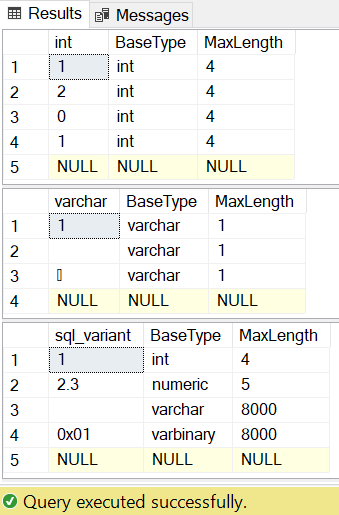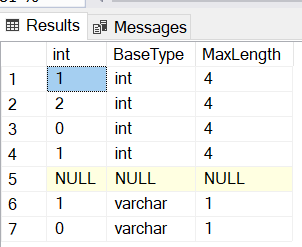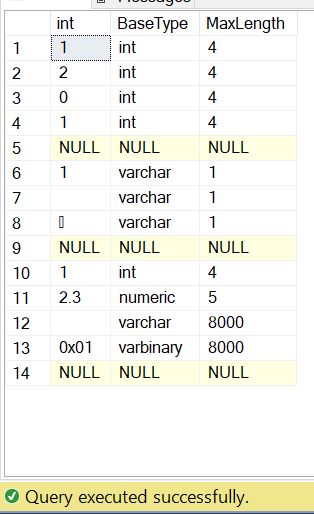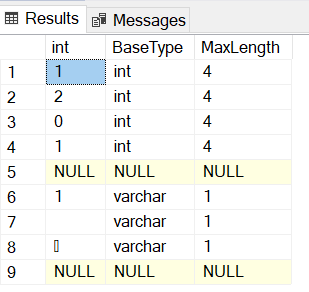T-SQL Tuesday 136 - sql_variant to the rescue
This month the #TSQL2SDAY invitation comes from Brent Ozar (blog|twitter). Brent wants us to write about our favourite (or least favourite) data types. The invitation is in this post.
sql_variant
Of all data types available in SQL Server – sql_variant is one of the most interesting to me. The Microsoft documentation writes all about it, this is probably the most important thing:
A data type that stores values of various SQL Server-supported data types. sql_variant MS Docs
Data type doo-doo-doo-doo
Let’s see how it works in the real world. Firstly, create some tables to play with. Each table has two columns: first – stores the first letter of the datatype second – values inserted
create table int (type char, int int);
create table varchar (type char, varchar varchar);
create table sql_variant (type char, sql_variant sql_variant);
Secondly, we are going to populate each table with the same insert.
insert into int values ('i',1);
insert into int values ('i',2.3);
insert into int values ('i','');
insert into int values ('i',0x01);
insert into int values ('i',null);
insert into varchar values ('v',1);
insert into varchar values ('v',2.3);
insert into varchar values ('v','');
insert into varchar values ('v',0x01);
insert into varchar values ('v',null);
insert into sql_variant values ('s',1);
insert into sql_variant values ('s',2.3);
insert into sql_variant values ('s','');
insert into sql_variant values ('s',0x01);
insert into sql_variant values ('s',null);
When you run it you may noticed that the this line fails
insert into varchar values ('v',2.3);
with the error:
Msg 8115, Level 16, State 5, Line 101
Arithmetic overflow error converting numeric to data type varchar.
The statement has been terminated.
Hey, 2 out of 3 worked fine! Let’s see what we have there. In this part, we are going to use the SQL_VARIANT_PROPERTY function to find out what data types hiding there.
select int, SQL_VARIANT_PROPERTY(int, 'BaseType') AS 'BaseType', SQL_VARIANT_PROPERTY(int, 'MaxLength') AS 'MaxLength' from int;
select varchar, SQL_VARIANT_PROPERTY(varchar, 'BaseType') AS 'BaseType', SQL_VARIANT_PROPERTY(varchar, 'MaxLength') AS 'MaxLength' varchar;
select sql_variant, SQL_VARIANT_PROPERTY(sql_variant, 'BaseType') AS 'BaseType', SQL_VARIANT_PROPERTY(sql_variant, 'MaxLength') AS Length' from sql_variant;
As we can expect the first two are returning int and varchar, but the third one is very much different:
 We can also see that the int and varchar table did not store the values we’ve provided as they either tried to convert them to respective data type or failed to insert, while sql_variant stores them all nicely.
We can also see that the int and varchar table did not store the values we’ve provided as they either tried to convert them to respective data type or failed to insert, while sql_variant stores them all nicely.
Not my type – sorry
The above is a result of three separate SELECT statements, but in SQL we could use UNION ALL. Firstly, let’s have a look at how the different types behave:
select int, SQL_VARIANT_PROPERTY(int, 'BaseType') AS 'BaseType', SQL_VARIANT_PROPERTY(int, 'MaxLength') AS 'MaxLength' from int
union all
select varchar, SQL_VARIANT_PROPERTY(varchar, 'BaseType') AS 'BaseType', SQL_VARIANT_PROPERTY(varchar, 'MaxLength') AS 'MaxLength' varchar;
Indeed, we get some results and an error, i.e. the int did not like some of the entries from the varchar table. Check yourself happens when we put the select statements in reverse order.
Conversion failed when converting the varchar value '' to data type int.

We know that there might be some issues with the union of two tables holding different data types, but what happens when we add a d table – sql_variant to the party and make it treble.
select int, SQL_VARIANT_PROPERTY(int, 'BaseType') AS 'BaseType', SQL_VARIANT_PROPERTY(int, 'MaxLength') AS 'MaxLength' from int
union all
select varchar, SQL_VARIANT_PROPERTY(varchar, 'BaseType') AS 'BaseType', SQL_VARIANT_PROPERTY(varchar, 'MaxLength') AS 'MaxLength' varchar
union all
select sql_variant, SQL_VARIANT_PROPERTY(sql_variant, 'BaseType') AS 'BaseType', SQL_VARIANT_PROPERTY(sql_variant, 'MaxLength') AS Length' from sql_variant;
As a matter of fact, no errors, and all the rows are there.

Oh, and it even works when we truncate the sql_variant table and keep it in the UNION.

Enough playing, you can drop the tables now.
Where in the world?
There are few places in the SQL Server when you can find the sql_variant column, here is a quick query to find these objects:
select OBJECT_NAME(object_ID)object,name from sys.all_columns where system_type_id in (
select system_type_id from sys.types where name = 'sql_variant')
order by object,name;
Summary
Although it looks very tempting to use sql_variant more often it may not be the best idea – there is a number of examples where not to it: one from Brent and Phil.
Thanks,
Mikey

